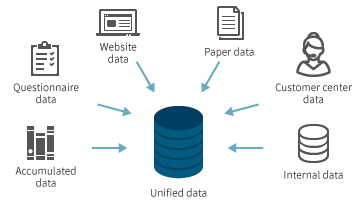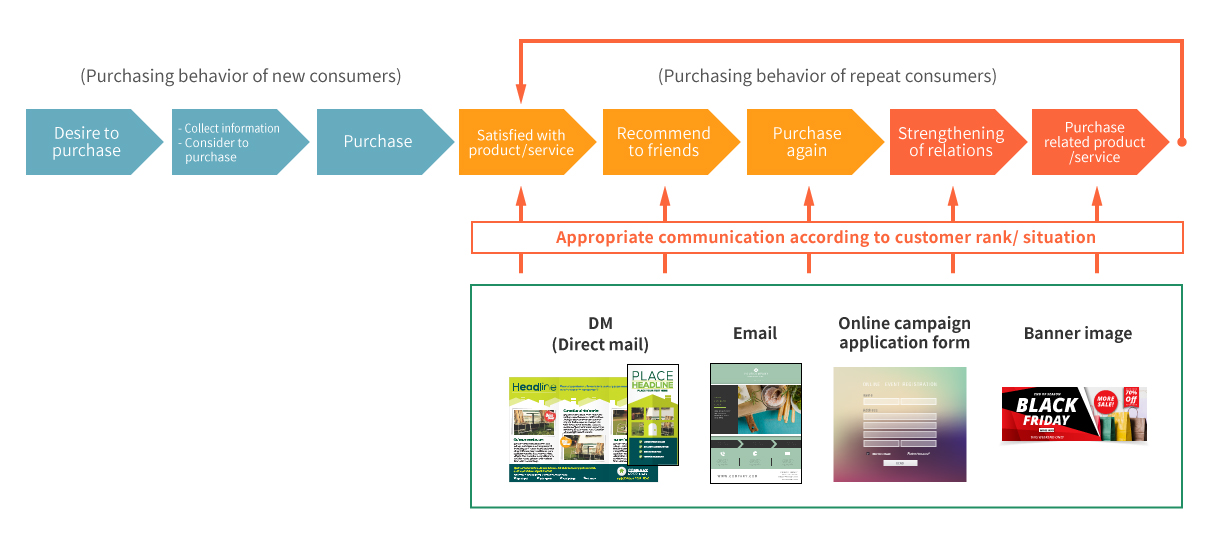Overview of CRM
Implementation of CRM -- We start with your customers. (Customers always come first)
In CRM, "customer" is taken as the starting point of thinking at any occasion. Overview of CRM is, accumulate and manage customer data, analyze data from various point of view to materialize the customers, plan and execute the communication with customers, evaluate the results, implement improvement activities. This series of workflows (PDCA) done continuously.
CRM workflow
(1) Accumulation and management of customer data
The first thing you need is to know about your customers. Customer data is indispensable for that.
The following is an example of customer data.
- (Basic profile) Name, Email address, Phone number, Address, Gender, Age, Occupation etc.
- (Purchase information) Product, Purchase price, Purchase place, Warranty situation etc.
- (Access information) Usage of website (Login history, Browsing history of website contents, etc.)

If you do not own customer (=end user) data due to your dealers sell your products and services, the first thing need to do is to create a mechanism that accumulates customer data at your side. An example of the mechanism is warranty website which product’s warranty information can be checked on the site, or membership website which members can enjoy exclusive contents and experiences by being a member.
Even if customer data exist at hand, there are many cases that preparation for these data is needed in advance. For example, there are many data internally with different format such as in digital like CSV and excel, and in paper like questionnaire, warranty card etc. In such a case, it is necessary to consolidate the data format and clean data that can not be used. This is important preparations for CRM.
(2) Customer data analysis - Visualization of customers
In this step, analyze collected customer data. The way of analysis varies from company to company, but the following is common.
- Contribution level: Contribution to sales so far (Total spent)
- Purchase behavior: Purchase trend such as average spent per purchase, # of item, purchase frequency, recent purchase date, etc.
Carrying out the analysis by combination of above and basic profile data such as gender, age, location, etc. By doing this, it is possible to grasp current trend of your customers to find improvement points. Also at this timing, it is better to create the definition of your customer rank to record the changes. In the following example, customer rank is defined in 4 groups, but it is also possible to define more detailed conditions and more ranks. The important point is that customer rank is defined in order of contribution to sales to the company.
[Example of customer rank]

| Definition of customer rank | # of customer |
Sales (THB) |
|
|---|---|---|---|
| VIP | Total spent is more than 30,000 THB, or total # of item is more than 8 (in recent 3 years) | 2,000 | 110,000,000 |
| Repeat customers | Total spent is 10,000 ~ 29,000 THB, or total # of item is 3 ~ 7 (in recent 3 years) | 5,000 | 120,000,000 |
| New customer | Total spent is less than 9,999 THB, or total # of item is 1 ~ 3 (in recent 3 years) | 20,000 | 70,000,000 |
| Potential customer | Never purchased | 8,000 | - |
(3) Create a communication plan
In other words, CRM is "Optimizing communication with customers". The communication plan includes “to who (= customer segmentation), what action we expect (= objective), what kind of message (= content), how to deliver (= communication method)” based on the analysis results in previous step.
[Example of communication plan]
| Customer segmentation | Objective | Content | Communication method | KPI | ||
|---|---|---|---|---|---|---|
| Rank | Other condition | # of customer | ||||
| VIP | - (all) | 2,000 | Maintain royalty by expressing they are most important customers to us |
“Exclusive special event for VIP customers” Enjoy special dinner and limited item sale event at XX hotel |
・Phone ・DM (Direct mail) |
20% of eligible customers apply for the event |
| Repeat customers | No purchase within a year | 3,000 | Prevent dormancy |
"New product trial campaign" Lend a new product for free for a certain period to all applicants |
15% of eligible customers apply for the campaign | |
| New customer | - (all) | 20,000 | Let them remember us for future purchase |
“Thanks message” Thanks message for first purchase, Tips on how to use, how to care the product |
30% of eligible customers open the email | |
| Potential customer | - (all) | 8,000 | Provide opportunities to purchase |
"Welcome Campaign" Give a free gift with your first purchase within the campaign period |
・Email ・SMS ・Online advertising |
10% of eligible customers purchase |
(4) Execute the communication plan
After communication plan created, communication tools such as direct mail, email, online campaign application form, banner image, etc is needed. These items should be effective for target customers. After prepared, send message to each customers.

(5) Check the results
Check the numerical result of the executed communication such as.
- Difference between KPI and actual # of participants of event
- Difference between KPI and actual # of applicant of campaign
- Difference between KPI and actual email open rate
- Difference between KPI and actual # of customers who purchase products
(6) Analyze the results
Guess the factors that behind the actual results above, and utilize it for improvement.
[Examples of factors when the result didn’t achieve to KPI]
- The KPI itself was an unrealistic figure
- The campaign / event was not attractive to the target
- User flow is not well designed (e.g. “how to apply to campaign” was hard to understand, campaign application page was not user-friendly)
- Email content was too long to read all
- Email subject was difficult to understand to cause low email open rate
The power of Continuation
This (1) ~ (6) are not so make sense if they are executed only once. It is necessary to repeat to build your own winning pattern. CRM is a management method aiming to strengthen relationships with customers through continuous communication. It is same as an individual to individual relationship, it is hard to build a strong relationship by only one time communication.Continuation is power.

